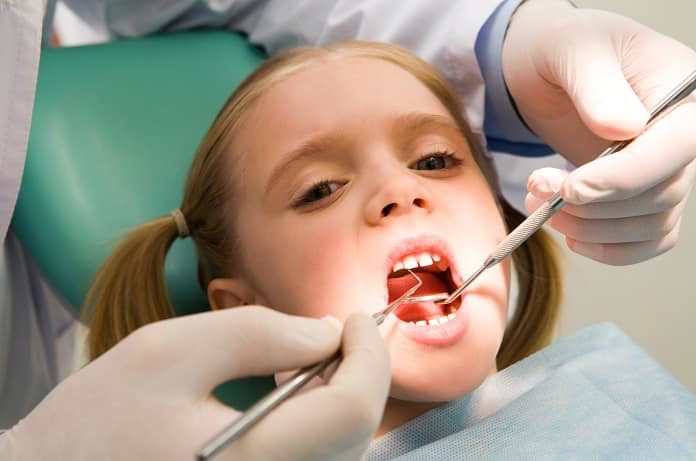A study investigated the prevalence of obesity and oral diseases in children, looking at common risk factors and links between the two diseases.
Obesity and oral diseases in childhood are associated with negative influences on both the health and psychosocial status of a person. Oral diseases put children at serious health risks, and the pain and further complications can cause them to miss school. It has likewise been shown that obese children tend to have lower achievements in school and have a reduced quality of life. Beyond increasing the risk of the child developing chronic illnesses, obesity can put a child at a disadvantage socially and economically.
Obesity and oral diseases in children tend to persist into adulthood, and some behavioural factors, such as diet and dental hygiene, may increase the likelihood of the next generation having the diseases. Furthermore, oral diseases may contribute to chewing problems, which translate into dietary problems. Children with missing or painful teeth may avoid nutritional foods, such as fruits, and increase consumption of processed, unhealthy foods. These children are thus at risk for both under-nutrition and obesity.
What is the Connection between Oral Diseases and Obesity?
Studies have found that in New Caledonia, a French overseas territory in the South Pacific, adults, especially of Polynesian ethnicity, are significantly overweight (67%). However, no such data has been collected about children. Thus, a new study set out to determine the prevalence of obesity and oral diseases in children aged 6, 9, and 12 years old. In New Caledonia, there are several different ethnicities, between which social, economic, and health disparities have been reported. The study further attempts to identify the environmental, ethnical, and individual risk indicators of oral diseases in 12-year-old kids. Moreover, the study looks at how masticatory (chewing-related) dysfunction affects the occurrence of both diseases.
As published in BMC Public Health, almost 3,000 students were surveyed and tested by dentists and assistants for oral diseases and weight matrices. The children were then classified into four groups: Healthy Group (HG), Oral Diseases Group (ODG), Obesity Group (OG), and Oral Diseases and Obesity Group (ODOG). The assessments for oral diseases were done via a clinical examination, recording such variables as numbers of missing teeth, presence of gingivitis, etc. Chewing efficiency was also recorded by counting the number of posterior functional dental units, previously shown to be linked to chewing ability in children.
Researchers assessed weights by collecting body mass index (BMI) values, as well as waist to height ratio. BMI scores were used to determine whether the child was normal weight, overweight, or obese. A high waist to height ratio would indicate a high risk for developing metabolic syndrome, a cluster of diseases which includes high blood pressure, high blood sugar, etc. Questionnaires were also assigned to the children, which evaluated their behaviour (e.g. frequency of tooth brushing), their experience with dental care (already visited a dentist?), and their perceived dental condition (pain or chewing difficulties). They were also asked which ethnicity they identified with.
Strong Link Found Between Oral Diseases in Obesity in Children
Out of the 1,201 12-year-olds in the study, only 36% fell into the healthy group. 27% fell into the oral diseases group, 19.7% into obesity group, and 16.5% into the oral diseases and obesity group. That means that every fourth child had oral diseases, and one out of six children would be both obese and experience oral diseases. In fact, 62% of the 12-year-olds have shown symptoms of localized or extended gingivitis (an inflammation of the gums). Almost 20% had less than six posterior functional dental units to chew. The prevalence of overweight increased greatly between 6 to 9-year-olds, and particularly obesity increased significantly by the age of twelve. In fact, the study determined that one third of the 12-year-olds suffered from excess body fat, and most of these were at risk for metabolic syndrome.
Environment and Ethnicity Significantly Correlated with Health
The results showed that the environment significantly correlated with the children’s health. Children from the Islands tended to fall into the oral diseases group, while children in the north in both the oral diseases group and the obesity and oral diseases group. Specifically, children from the North and the Islands had a three- and two-times higher likelihood respectively of developing oral diseases than children from the south. In fact, this was the strongest correlate for oral diseases.
Ethnicities also correlated with health risks. Polynesian ethnicity was the strongest correlated variable for the risk of obesity and oral diseases. Behavioural habits, such as brushing teeth less than once a day, also correlated with both diseases. Surprisingly, however, dietary habits such as having lunch at school or consuming sweet drinks did not correlate with obesity rates. Moreover, having less than six functional posterior units, indicating chewing problems, strongly correlated with obesity ratings.
The study did lack in its use of self reports for behavioural data, and that data was also dichotomised (yes or no answers). More detailed answers may have provided more insight and precision, especially for nutritional variables. It is also of note that different scales measure cut-offs for obesity and overweight values differently, making some of the results meaningful in one scale, but not in the other.
Targeted Prevention Strategies Required
Nonetheless, this study demonstrates the need to implement stronger prevention techniques with New Caledonian children. Treatments should also be increased to deal with both oral diseases and obesity. Based on these results, one can see that oral diseases could influence obesity ratings too, as is the case with chewing difficulties. Therefore, there is a need for programs that implement an intervention in both oral and dietary aspects. Further research is still needed in this area, however, as well as in exploring further the effects of sugary drinks consumption.
Written by Maor Bernshtein
Reference: Tubert-Jeannin, Stéphanie, et al. “Common risk indicators for oral diseases and obesity in 12-Year-Olds: a South Pacific cross sectional study.” BMC Public Health, vol. 18, no. 1, 8 Jan. 2018, doi:10.1186/s12889-017-4996-y.



